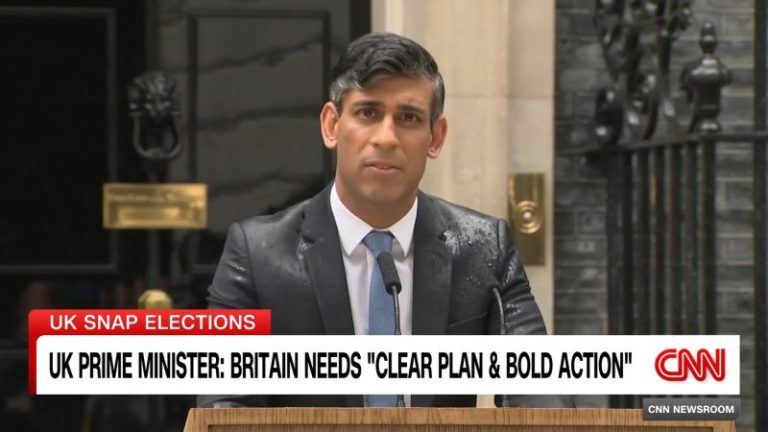When British Prime Minister Rishi Sunak announced on Wednesday that the United Kingdom would hold a general election on July 4, many observers wondered: why now?
More specifically, why has the PM called an election that is almost certain to lose? For months, polls have placed Sunak’s Conservative Party way behind the opposition Labour Party and, as things stand, Labour leader Keir Starmer is set to not only win power but have a massive parliamentary majority.
The answer to that question is simple: it’s very unlikely there will be a better time. Almost everything Sunak tries seems to backfire, and it’s not implausible that his favorability with the public will get even worse before the end of the year.
The past couple of days have been relatively good for Sunak. The economy does seem to be recovering, with the International Monetary Fund (IMF) updating the UK’s growth forecast and inflation finally returning to something resembling a normal level.
Nothing went catastrophically wrong in the last week or so ahead of calling the election. It’s a low bar, but since his time in office, right now he probably has the most stable base to launch a campaign that he’s ever had or ever will have.
“The PM came into office facing a series a key challenges: inflation, no growth, migration. And he saw dealing with those as his primary mission. And he’s made genuine and significant progress on that. On Tuesday, the IMF upgraded our growth forecasts, yesterday we saw inflation back to normal levels, today we see migration falling as a result of our reforms.
“So we’ve got a solid foundation to say that things are going in the right direction, and the view was that now was the best time to go to the country and say ‘here’s what we’ve done, our plan is working, now who do you think has the plan and the capacity to take the bold action to move this country forwards towards a more secure future.’”
Sunak had to call the election before the end of this year, constitutionally speaking. The fact he hadn’t until this week allowed his opponents to paint him as a coward, terrified of facing the public.
It didn’t help that the country has felt in need of an election for quite a long time, nor that the Conservative Party has looked from the outside like a basket case for a number of years.
Their time in office didn’t begin formidably. In 2010, after 13 years of Labour rule, David Cameron won the general election but didn’t win a majority in parliament. He was forced to make a coalition government with the centrist Liberal Democrats.
Cameron, against the odds, kept the coalition together until the 2015 election, at which he won a surprise majority and secured the first fully Conservative government since 1997.
The celebrations didn’t last long. Holding the 2016 Brexit referendum split his party in two and made governing nearly impossible for his four (yes, four) successors. First up was Theresa May.
A botched snap election and the inability to pass her Brexit deal because her party hated it ended May’s tenure, and she was replaced by Boris Johnson in 2019. Johnson blew his own majority when he became so weighed down by scandal – including the notorious illegal parties in Downing Street during the Covid-19 pandemic – he had to resign in 2022.
Liz Truss took over for 45 days, in which time she managed to cause sufficient economic havoc that the pound sank to its lowest ever level against the dollar, interest rates spiked and inflation ballooned. Eventually, the Conservative Party had enough of the chaos and put Sunak in charge as a safe pair of hands.
Whether or not he has been that is up for debate. Despite what Conservative sources might say about his record in office, his dire poll ratings cannot be denied.
His flagship immigration policy, which would see illegal migrants sent to Rwanda to have their asylum claims processed, has already cost millions despite the fact only one person – voluntarily and given money to do so – has made the trip.
His world-leading smoking ban, which caused Sunak major embarrassment when his own MPs didn’t approve it, has been shelved due to the election.
These are just two recent examples of how things seem to go wrong for Sunak. But the most damaging issue around him is the general sense that he is a bit of a loser and that his own party has so little faith in him. No amount of facts, figures or soundbites can change that he has an undeniable stench of failure around him. The sense that something is inevitable is powerful in politics, and for Sunak, defeat seems inevitable.
Of course, it isn’t. There is a chance that the polls are misleading us, and there is a chance that the Conservative campaign will work.
They are making it personal: a clear choice between Labour leader Starmer and Sunak. Conservatives claim Starmer cannot be trusted on national security, is a shameless opportunist with no principles and has no plan.
Right now is probably the best time to hammer that message home. Labour will have to rush out its manifesto, which will inevitably be picked apart by commentators. The longer Sunak held off, the more time Labour had to get its house in order.
Sunak inherited a mess, no one can deny that. It currently seems unlikely that he has cleaned up that mess enough to earn the Conservatives another term in office. But given the size of the task ahead of him, it makes sense that he seize on this rare period of good news and hope for the best.

